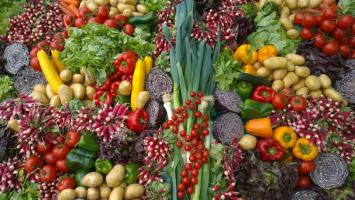
DIET & LIFESTYLE
DISCOVER HOW TO HEAL
Called doshas in Sanskrit, they refer to the internal processes that change body type or constitution. Knowing them provides helpful clues for both healing from and preventing disease. And the easiest way to understand them is by exploring their effects — a shift in qualities or biocharacteristics, such as hot and cold, dry and wet. This biocharacteristic theory of medicine may seem odd to Westerners. But Ayurveda has successfully treated patients this way for thousands of years. User-friendly and powerful, it helps physicians and lay people alleviate disease, improve quality of life, and harmonize their bodies with natural substances from their environment. Let's take a closer look. What Dosha Type are You?Are you often cold? Do you have dry skin and experience gas and bloating after eating? Dry and cold are Vata's main qualities. Vata also energizes.Or maybe you're often hot. Do you get irritable and intense easily? Intensity and heat are main biocharacteristics of Pitta. If you are often cold, and tend to be sluggish, your dosha may be Kapha, whose predominant biocharacteristics are cold and wet (oily). While Ayurveda is much more than doshas, understanding their effects, the qualities, is a good place to start. (If you don't already know your dosha, click here.) Everyone has energy, heat and moisture, so all 3 doshas are present in every person. The relative strength of each dosha determines your overall biocharacteristics & body type. Most of us have one or two doshas that predominate. Often that second dosha is Pitta, which adds an element of heat when associated with either Vata or Kapha. For example, Pitta-Vata is hot and dry. Pitta-Kapha is hot and wet. The following diagram illustrates the predominant biocharacteristics for each of the three doshas. 
Explore Your ImbalancesIn sanskrit the word dosha means that which is corruptible. The three doshas, then, refer to three primary ways your body or constitution changes. More formally, a dosha is
So while discovering your dosha and body type can be interesting and fun, asking "What dosha is causing my recent imbalance?" can yield more practical information about current and future health conditions. To explore this question, start by considering the factors that affect your doshas. These include your age, the time of year and the time of day. One dosha dominates each stage of life. Your stage of life can exaggerate or decrease the tendencies of your particular constitution.
How Dosha Types Metabolize & Store EnergyYour doshas are just an approximation of your physical tendencies . However, they can offer valuable clues as to how you metabolize and store energy.Understanding them gives you a broad perspective, like looking at the forest instead of the trees. Your metabolism and physical characteristics, in turn, affect your mental tendencies. Vata people scatter or lose energy. When out of balance they tend to be hyperactive, underweight, anxious, dehydrated and exhausted. On the positive side all this physical stimulation can make Vata's creative, imaginative and outgoing. Pitta manages energy well. They tend to be focused, disciplined and logical, traits that make them good leaders. When out of balance, their internal heat and intensity can make them argumentative and critical with a fiery temper. Kapha people store energy and are often overweight and congested. With a sluggish metabolism, they tend towards a couch potato lifestyle. They can also be nurturing, stable and affectionate. Change & Your Ayurvedic Body TypeAyurveda defines disease as any change from "normal" (homeostasis) in the body.However, change is a daily event causing imbalances to which your body must react in order to bring doshas and their qualities back into balance and good health. Fortunately, there are mechanisms in place to buffer and protect your body from these stressors. While these mechanisms provide a healthy cushioning effect, they also cause physical changes that Ayurveda classifies as aggravation. For example, your body must make accommodations for seasonal climate change. But these accommodations can leave behind excess qualities such as heat as you transition from summer to fall and winter, or wetness as winter melts into spring. The excesses cause changes that can accumulate and eventually aggravate and weaken your body. In the fall and spring, Ayurveda recommends seasonal cleanses to clear these residues. Balancing the DoshasA body in balance is a body in homeostasis. When your body is healthy it automatically repairs and protects itself.When doshas are aggravated or provoked, resulting imbalances can stress your body and lead to disease if not corrected. And whenever one dosha is out of balance, it knocks the other two out of balance as well causing more havoc in your body. Imbalances are often the result of poor food and lifestyle choices. Healthy food options for a Vata person imbalanced in dryness are ones with nourishing, wet or oily qualities that plump up their tissues and soothe their parched digestive tracts.. If, instead, they forget to drink water, skip meals, snack on dry crackers, chips and popcorn, and over exercise, dryness may begin to accumulate aggravating their tissues. If they don't take action to reverse this trend, the dryness can eventually overwhelm their tissues and cause increasingly alarming symptoms. A little gas after a big meal due to a dry digestive tract may develop into chronic constipation or worse. The biocharacteristic theory of medicine uses opposite characteristics to create balance. If your body runs cold, Ayurveda recommends foods that warm like hot drinks, soups and stews. If it is wetness that is in excess, your best diet choices may be astringent foods like cranberries, lentils or raw apples. Help is AvailableDosha is an advanced concept. People new to Ayurveda should focus on balancing biocharacteristics first, then doshas.For help with balancing and healing your doshas, a consultation with a trained Ayurveda health counselor can help you learn techniques to find your state of perfect health. Your counselor will suggest lifestyle, diet and herbs to rebalance your body. In addition, they may suggest a seasonal cleanse to help balance your doshas by removing buildup and accumulation. Tonifying therapies can strengthen deficiencies. Read more about each individual dosha (Vata, Pitta, Kapha) to learn how to balance it. If you don't know your body type, take the quizzes on Joyful Belly to find out. If you do know your body type, start catering to its digestive needs by clicking one of the links below! Is Vata your main body type (dosha)?Are you creative and imaginative? Do you have an active mind that understands easily and forgets just as fast because it's quickly on to other things? Do you have weak digestion causing gas and bloating? Or maybe you suffer from anxiety and sleeplessness due to racing thoughts that keep you awake at night. Are your hands and feet often cold? If you identify with these traits and symptoms your main constitution may be Vata. Or you could be imbalanced in qualities associated with Vata. Vata is a subtle dosha and easily stimulated. It is quick to go out of balance causing a range of health problems. Fortunately, Ayurveda can help. What is Vata?Vata literally means "wind," in Sanskrit.One of Ayurveda's three doshas, Vata refers to all bodily processes that are catabolic, dry out the body, or trigger movement. In contrast Pitta refers to all bodily processes that are metabolic, generate heat, defend, or regulate. Kapha refers to all bodily processes that are anabolic, moisten and nourish, or repair. Each or the doshas is also defined by imbalances of certain biocharacteristics or qualities. In Vata's case these are dry, light, cold, rough, subtle and mobile. An example of a Vata imbalance is symptoms of dryness. Dry symptoms include dry hair, dry skin, a dry digestive tract (lack of digestive fluids), or dryness in your joints. Vata also shows up as deficiency. One of Vata's main effects is to activate and use up stored energy in the body. This essential function of breaking down proteins, fats and other nutrients (defined as catabolic in Western medicine) releases the energy within nutrients for use . But continuously breaking down can lead to deficiency. To stay balanced Vata people must choose diet and lifestyle habits that rebuild. Vata also makes movement in your body possible. This would include muscles, nerve impulses, and thoughts. Vata senses are hearing and touch. Some common characteristics of Vata constitutions are:
What is Vata Like?When Vata's qualities are in balance, these folks are vivacious, and outgoing.They are always up for an adventure and easily adapt to change. They enjoy being on the go. However Vata's have a highly sensitive nervous system. They are quickly overstimulated and imbalanced. When that happens, they can become anxious, flighty, dehydrated, constipated, and exhausted. And all of this can leave them feeling and acting erratic and scattered. The senses closely associated with Vata are hearing and touch. (If you don't know your main dosha, and would like to find out, take our free dosha quiz.) What Happens When Vata is Out of Balance?We all have Vata at work in our bodies. (Otherwise nothing would move and/or change.)However, some of us have more Vata qualities than others. Some common Vata symptoms, or signs of imbalance, include:

Vata's Ayurvedic ClockAyurveda teaches that good health requires us to be in sync with nature and our body's natural biorhythms or clock. These include a variety of cycles such as daily and seasonal rhythms, one's passage through life, as well as digestion, and pregnancy.Vata comes at the end of each of these cycles, the end of the digestive tract, the end of pregnancy, the end of the day, the end of the year, and the end of a person's life. Its qualities naturally increase during these times, upping a person's chances of imbalance. Vata increases:
This could be due to the influence of one of the other doshas. For example, Vata and Pitta dosha may dominate in your body, or Vata and Kapha dosha. Vata Sites of the BodyCertain sites in the body are places of greater Vata activity.Colon - The body reabsorbs moisture from feces before elimination from the colon. If the body is dry, it absorbs too much water from stool, causing dryness in the colon. Signs of dryness include gas and constipation. Waist & Lower Half of the Body - When Vata is elevated, the body becomes more mobile and the mind more active. As a result one tends to forget about the lower half of the body. Bones - Vata's poor digestion reduces mineral absorption. Mineral deficiencies show up as white spots on the nails, hair loss, osteopenia, or arthritis. Problems with bones, nails, and hair are due to high Vata. Skin - When toxins (ama) from the colon corrupt blood chemistry, the kidneys try to eliminate the toxins through urination. The result is loss of fluids leading to dry skin. Vata is also the dosha of touch. Ears - Ringing in the ears is due to high Vata. When the quality of the blood is poor due to ama, the nervous system and sense organs get stimulated. The ears are especially sensitive. Many Vata people are musicians. Mind - When Vata is elevated, the mind becomes stimulated, anxious, or afraid. Vata people often experience racing, disjointed thoughts. They are highly imaginative and quickly understand, but also quickly forget. How to Balance VataSweet, sour and salty foods give Vata the nourishment, moisture, and nervous stability they need to rebuild.Vata folks are best soothed by routine, warmth and good quality oils in their diets and on their skin. Their lifestyle needs stability - taking time to slow down and rest, as they tire easily and are quickly overstimulated. Their best diet consists of foods like root vegetables, whole grains and animal products to ground their airy natures. Vata Should Avoid These Foods

Avoid Food With These Vata Qualities





READ MORE ON THIS TOPIC
BROWSE SIMILAR ARTICLES BY TOPIC

About the Author John Immel, the founder of Joyful Belly, teaches people how to have a healthy diet and lifestyle with Ayurveda biocharacteristics. His approach to Ayurveda is clinical, yet exudes an ease which many find enjoyable and insightful. John also directs Joyful Belly's School of Ayurveda, offering professional clinical training in Ayurveda for over 15 years.John's interest in Ayurveda and specialization in digestive tract pathology was inspired by a complex digestive disorder acquired from years of international travel, as well as public service work in South Asia. John's commitment to the detailed study of digestive disorders reflects his zeal to get down to the roots of the problem. His hope and belief in the capacity of each & every client to improve their quality of life is nothing short of a personal passion. John's creativity in the kitchen and delight in cooking for others comes from his family oriented upbringing. In addition to his certification in Ayurveda, John holds a bachelor's degree in mathematics from Harvard University. John enjoys sharing Ayurveda within the context of his Catholic roots, and finds Ayurveda gives him an opportunity to participate in the healing mission of the Church. Jesus expressed God's love by feeding and healing the sick. That kindness is the fundamental ministry of Ayurveda as well. Outside of work, John enjoys spending time with his wife and 7 kids, and pursuing his love of theology, philosophy, and language. STUDY AYURVEDA
Questions, Comments & Impressions of 'what is vata dosha? (plus how to keep it balanced & healthy)'?Is there something else you'd like to know about 'what is vata dosha? (plus how to keep it balanced & healthy)'?     (4.90 out of 5 stars) 10 ratings, 305 likes (4.90 out of 5 stars) 10 ratings, 305 likes     Sign in to review this article Sign in to review this article
This is my second attempt to understand the Ayurvedic way of life. I get it. It seems like so much but I am now feeling it. Thank you. WOW.
At first I was a little skeptical since I work in traditional medicine, but the more I read I am amazed at how right on the description of my condition fits me!
Great article and easy to understand
Always very helpful. Understanding Ayurveda more and more everyday! Thank you.
Danita, consider making an appointment with one of our practitioners for a one on one consultation.
Sweet taste and heavy foods are balancing to both Vata and Pitta. Consider ordering one of our custom made Personal Body Books or getting a one on one consultation with one of our practitioners.
|
Join Joyful Belly.
Want our top Ayurvedic recipes and health tips?Subscribe to our free newsletter!

 SAVE ARTICLE
SAVE ARTICLE

 On MeWe
On MeWe On Pinterest
On Pinterest On Facebook
On Facebook On Twitter
On Twitter On WhatsApp
On WhatsApp On Email
On Email






